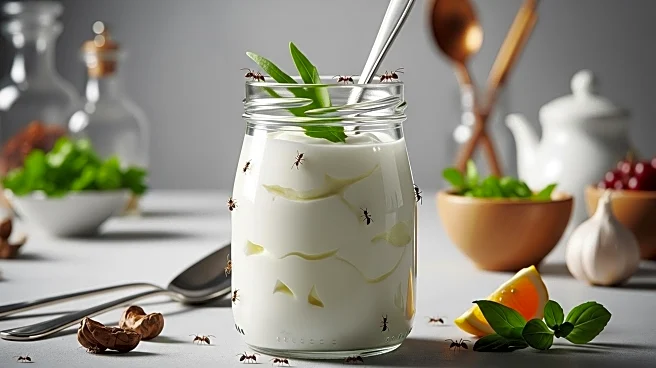What's Happening?
Researchers and Michelin chefs have teamed up to recreate an ancient yogurt recipe from Bulgaria that incorporates ants. The study, published in iScience, details how the acidic compounds carried by ants aid in the fermentation process of milk proteins, resulting in a yogurt with a tangy taste and herbaceous flavors. The project began with oral discussions and a field trip to a Bulgarian village where the tradition of ant yogurt fermentation was practiced. The local community identified the right ant species, Formica rufa, which were used in the fermentation process. The researchers found that the ants' formic, lactic, and acetic acids contributed to the yogurt's coagulation and fermentation, while their microbiome helped texturize the milk proteins.
Why It's Important?
This collaboration highlights the intersection of science and culinary arts, showcasing how traditional practices can inform modern food production. The study provides insight into the complex interactions between humans and other species, emphasizing the role of ants and microbes in food fermentation. The findings could influence future culinary innovations and sustainable food practices by utilizing natural fermentation processes. However, the researchers caution against attempting this recipe at home due to safety concerns, as ants are not authorized for sale as food products in Europe and may carry parasites.
What's Next?
The study's results have been shared with The Alchemist, a Michelin restaurant in Denmark, which has developed new recipes incorporating ants, such as an ice cream ant-wich and a milk wash cocktail. These culinary experiments may inspire further exploration of traditional fermentation methods and their applications in modern gastronomy. The research also opens up discussions on the ethical and regulatory aspects of using insects in food production, potentially influencing future food safety standards and cultural acceptance of insect-based ingredients.
Beyond the Headlines
The study underscores the importance of preserving traditional knowledge and practices, which can offer valuable insights into sustainable food production. It also highlights the interconnectedness of humans and other species, encouraging a deeper appreciation for the biodiversity that supports human life. This research may contribute to a broader understanding of the ecological and cultural significance of traditional food practices, fostering a greater appreciation for the role of diverse organisms in culinary arts.











